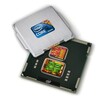Intel Core 2 Duo T9500 vs Intel Core i5-580M
Intel Core 2 Duo T9500
► remove from comparison
The Intel Core 2 Duo T9500 was a upper middle class dual core CPU for laptops at the time of introduction. It was intended to be used in the Santa Rosa platform due to the 800 MHz FSB. The T9550 is only slightly higher clocked but offers already a FSB1066.
Due to the relatively high clock speed and 6MB Level 2 cache, the T9500 offers enough performance for demanding games (in 2009) and applications.
The T9500 uses a Penryn (Montevina Update) core that features 2 integer units, 1 floating point unit, 1 load unit, and 1 store unit in a 14-stages long pipeline. Due to the Wide Dynamic Execution Technology, the core is able to simultaneously execute up to four instructions.
The integrated Enhanced Speedstep is able to downclock the core dynamically to save power (in idle mode).
Intel Core i5-580M
► remove from comparison
The Intel Core i5-580M is a high end dual core CPU for laptops and clocks (due to the Turbo Mode) from 2.66 to 3.33 GHz. Each core is based on the Nehalem (Westmere) micro-architecture. Hyperthreading enables the Dual Core CPU to handle 4 threads at once (for a better usage of the pipeline). Compared to the Core i7-620M, the 580M only has 3 MB Level 3 Cache.
A feature of the new Core i5-580M is the integrated graphics card called GMA HD and memory controller for DDR3-800/1066. Both are on a separate die that is still manufactured in 45nm whereas the CPU die is already manufactured in the new 32nm process.
The performance of the Core i5-580M should be a bit beyond the Core i7-620M and therefore the second fastest dual core CPU for laptops in 2010. Compared to the older Core 2 Duo models, the i5-580M should be faster than the T9900. Therefore, the Core i5-580M is a high end dual core cpu which should handle all daily work and gaming tasks. Only the quad core i7 CPUs can be noticeably faster at tasks that require four or more threads (e.g. rendering).
The 32nm cpu cores of the Westmere generation can also process some new instructions to accelerate AES encryptions.
The integrated Intel Graphics Media Accelerator HD (GMA HD) graphics card is known to be clocked up to 500-766 MHz and should be clearly faster than the old GMA 4500MHD. A GeForce 9400M (ION) should still be a faster (especially as Nvidia and ATI cards have a better driver support than Intel up to now). According to rumors, the GMA core will also use the Turbo Mode regulate the clock speed.
The power consumption of 35 Watt TDP (max.) counts for the whole package and therefore it is clearly better than the 35 Watt TDP of the Core 2 Duo T-series (CPU alone). Due to the Turbo Boost, the Core i5 is likely to use the whole TDP of 35 Watt under load and therefore can use more power than a similar specified Core 2 Duo. In Idle mode, the i5 uses clearly less power than the Core 2 Duo CPUs.
| Model | Intel Core 2 Duo T9500 | Intel Core i5-580M | ||||||||||||||||||||||||||||||||||||||||||||||||||||
| Series | Intel Core 2 Duo | Intel Core i5 | ||||||||||||||||||||||||||||||||||||||||||||||||||||
| Codename | Penryn | Arrandale | ||||||||||||||||||||||||||||||||||||||||||||||||||||
| Series: Core i5 Arrandale |
| |||||||||||||||||||||||||||||||||||||||||||||||||||||
| Clock | 2600 MHz | 2666 - 3333 MHz | ||||||||||||||||||||||||||||||||||||||||||||||||||||
| FSB | 800 | 4800 | ||||||||||||||||||||||||||||||||||||||||||||||||||||
| L1 Cache | 128 KB | 128 KB | ||||||||||||||||||||||||||||||||||||||||||||||||||||
| L2 Cache | 6 MB | 512 KB | ||||||||||||||||||||||||||||||||||||||||||||||||||||
| Cores / Threads | 2 / 2 | 2 / 4 | ||||||||||||||||||||||||||||||||||||||||||||||||||||
| TDP | 35 Watt | 35 Watt | ||||||||||||||||||||||||||||||||||||||||||||||||||||
| Transistors | 410 Million | 382+177 Million | ||||||||||||||||||||||||||||||||||||||||||||||||||||
| Technology | 45 nm, 1.0-1.25V | 32 nm | ||||||||||||||||||||||||||||||||||||||||||||||||||||
| Die Size | 107 mm2 | 81+114 mm2 | ||||||||||||||||||||||||||||||||||||||||||||||||||||
| max. Temp. | 105 °C | 105 °C | ||||||||||||||||||||||||||||||||||||||||||||||||||||
| Socket | BGA479, PGA478, PPGA478 | BGA1288, PGA988 | ||||||||||||||||||||||||||||||||||||||||||||||||||||
| Features | Virtualization Technolgoy (VT-x), Intel 64, Idle States, Enhanced Speedstep, Execute Disable Bit | Turbo Boost, Hyper Threading, Enhanced Speedstep, integrierte GMA HD 500-733MHz, Dual Channel DDR3 memory controller | ||||||||||||||||||||||||||||||||||||||||||||||||||||
| Architecture | x86 | x86 | ||||||||||||||||||||||||||||||||||||||||||||||||||||
| $530 U.S. | $266 U.S. | |||||||||||||||||||||||||||||||||||||||||||||||||||||
| Announced | ||||||||||||||||||||||||||||||||||||||||||||||||||||||
| Manufacturer | ark.intel.com | ark.intel.com | ||||||||||||||||||||||||||||||||||||||||||||||||||||
| L3 Cache | 3 MB |


 Deutsch
Deutsch English
English Español
Español Français
Français Italiano
Italiano Nederlands
Nederlands Polski
Polski Português
Português Русский
Русский Türkçe
Türkçe Svenska
Svenska Chinese
Chinese Magyar
Magyar